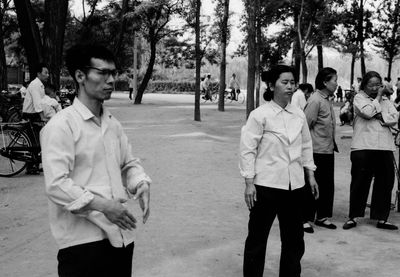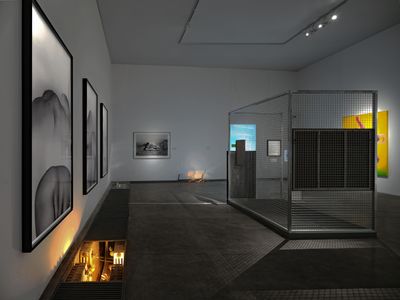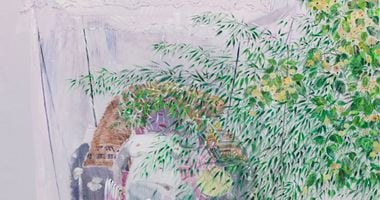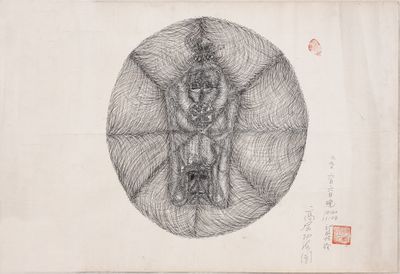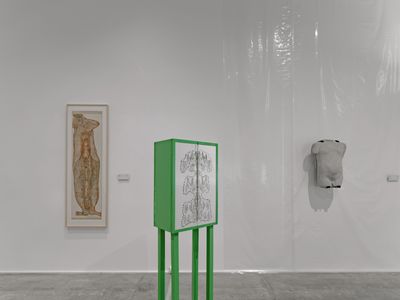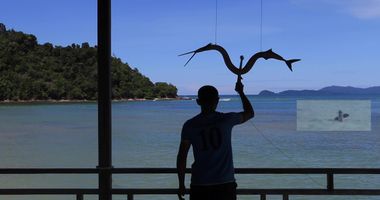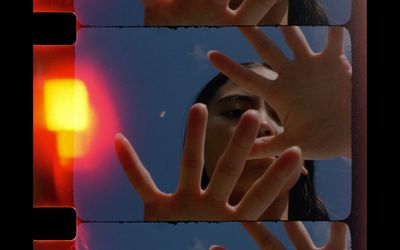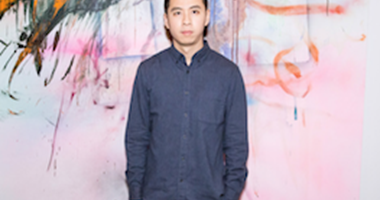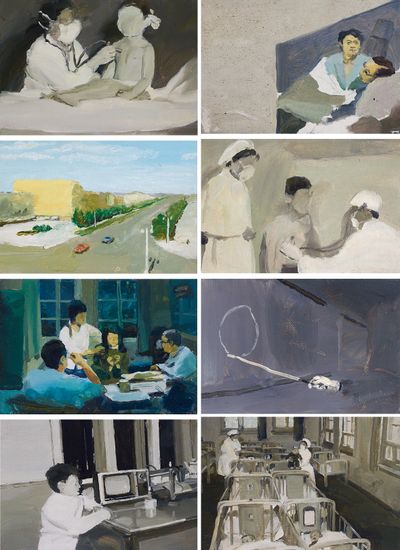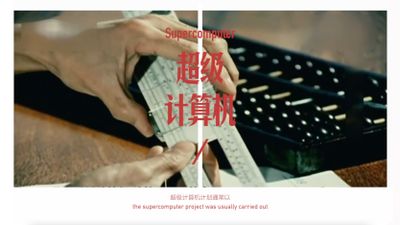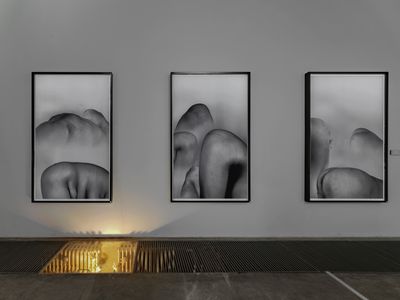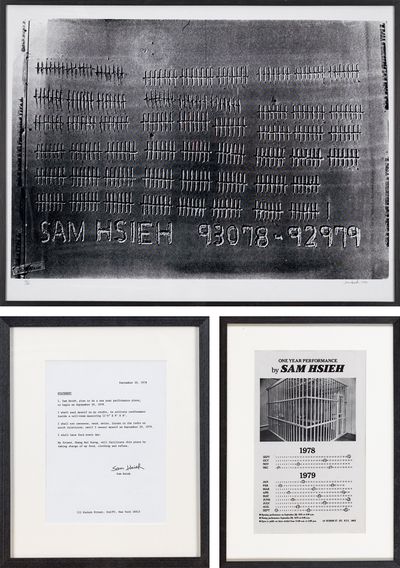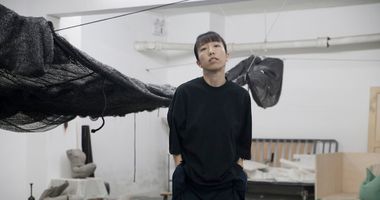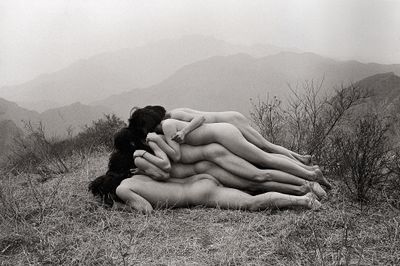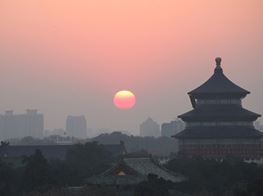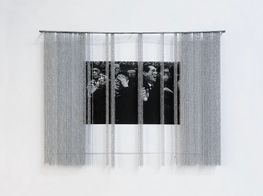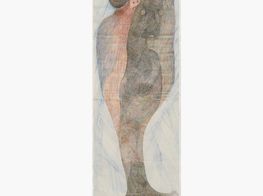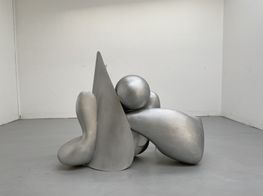At Beijing's Taikang Space, the Body Reclaims Its Potential

Exhibition view: Group exhibition, Bodily Reaction: Vitalizing the Bare Life, Taikang Space, Beijing (2 March–4 June 2023). Courtesy Taikang Space.
In 1982, in a black-and-white photograph titled Zizhuyuan Park, artist Li Xiaobin captured people exercising in a Beijing park. In the image, a man in a work shirt raises his hands and stares at the ground before him, while a woman standing next to him also gazes ahead. It reflects a moment of stillness in a busy city, and also portrays a movement that swept China.
The scene represents people taking part in the meditative practice of qigong, which underpinned a social phenomenon—referred to as the 'qigong boom' or 'qigong fever'—that arose in China in the 1980s and 90s. The popular movement, and sub-culture it spawned, saw millions adopt the practice of qigong believing it to strengthen the body, cure illness and, for some, to lead to supernatural abilities.
Tapping into this particular historical context, Bodily Reaction: Vitalizing the Bare Life at Taikang Space, Beijing (2 March–4 June 2023) gathers archival materials and iconic works largely drawn from the Chinese contemporary art collection of Taikang Life Insurance, coupled with newly commissioned videos and site-specific installations across its two gallery space.
The widespread practice of qigong was arguably a by-product of the market-driven healthcare reforms that took place in China in the 1980s, which left both rural and urban communities without access to publicly funded healthcare, making it difficult and costly to seek medical attention. As a result, many people turned to traditional medicine and the spiritual as alternative forms of care, and the movement's popularity was also accompanied by a rise to power of related 'grandmasters' as cultural and political leaders.
Curated by Chelsea Qianxi Liu and Wang Hongzhe, Bodily Reaction neatly sidesteps the cultish aspects of qigong fever to focus on the body's potential for sovereignty, proposing possible solutions for audiences to confront contemporary reality.
Two ink drawings by Guo Fengyi produced during this period, Diagram of Advanced Qigong Practice (1990) and Penguin Following the Path of the Qi Through a Human Body (1995), highlight the performative body linking directly to the practice of qigong.
One of the most prominent artists in the exhibition, Guo often references Chinese folklore, mythology, and traditional Chinese medicine in her works. After taking early retirement, the ailing former rubber-factory worker turned to qigong and began to draw the thoughts and visions manifesting on her spiritual journey.
Bodily Reaction neatly sidesteps the cultish aspects of qigong fever to focus on the body's potential for sovereignty...
Guo's works on paper reflect the movements of qigong, comprising repetitive, flowing lines that start at the centre of the paper and emanate outwards, resulting in mysterious, creature-like forms that seem to summon the formless energy flow referred to in the practice as qi.
Artist duo Future Host (Tingying Ma and Kang Kang) also reference the performative body and concept of qi in their 16mm film entitled Studies: Obliteration (2022).
Featuring experimental soundtracks, choreography, and repetitive footage, in the video a female dancer uses her body movements to materialise the energy flow around her, interacting with the natural and urban environment.
Although Bodily Reaction exhibits works created after 1980, some are haunted by the socialist collectivism rooted in the Mao era (1949–1976). Qiu Xiaofei's painting series '1984' (2003) references Orwell's famous anti-utopian novel in its title but also evokes childhood memories of the artist's generation, focusing on time in hospital.
One painting in the nostalgic series depicts the artist as a child in front of what could be a television set. By the mid-1980s television had become common in urban Chinese homes, and it was at this time that elements of science fiction, supernatural power, and spirituality first appeared in film and became popular nationwide.
Stills from these films, coupled with Qiu's experience of growing up in Harbin—a city that grew into a central industrial hub with Soviet aid in the 1950s—became references for the artist to deal with collective and personal memory.
The '1984' series suggests the frenzy for spirituality was not completely spontaneous but also fuelled by a government-led film industry. The allusion to the role of government places the exhibition's focus on qigong fever within a broader context. The United States and Soviet Union governments explored paranormal powers too, around the same period as China started to propagandise qigong and other forms of spirituality as science.
Qigong beliefs were endorsed by many prominent scientists including the astrodynamicist Qian Xuesen, who appears as a protagonist in Shi Qing's fictitious film Qian Xuesen and the Yangtze River Computer (2021). Borrowing its form from the reportage-style writing popular in the 1980s, the work is a direct response to the politicising of the supernatural.
Based on the history of socialist electronic technology development in China, from the Twelve-Year Science and Technology Development Plan to the digital mass movement and official research on extra-sensory perception, the film imagines a supercomputer project carried out in the 1980s.
From here, the exhibition gradually delves into an exploration of the political regulation of the body. The site-specific installation Bring me something I don't care (2023) by Zhang Yibei involved the artist removing several air grates on the floor and attaching organic, jellyfish-like forms to the cold central heating pipes. (It is worth noting that only the provinces on the north side of the Yangtze River are provided with central heating from November to March, an arbitrary policy that receives constant complaints.)
The second gallery envelops the audience in a dimly lit space where artworks emphasise the inhibited, isolated body, often depicted as fragmented, as seen in Liu Wei's Landscape (2004). The photographic triptych features black-and-white close-ups of nude bodies, which are portrayed or disguised as traditional Chinese ink-wash landscapes.
The sense of isolation is heightened by an iron cage placed in the centre of the room, a reference to Tehching Hsieh's One Year Performance 1978–1979 (1978–1979), also known as the 'Cage piece'. On the walls of the semi-open replica, a poster, statement, and photograph document how Hsieh subjected himself to extreme conditions inside a cell-like wooden cage for a year-long durational performance.
Hsieh's seminal work reverberates in Yu Ji's Stone Flesh 3 (2013), comprising a torso that appears like a marble-made classical sculpture from the Western art canon, but is cast in concrete and confined by iron bondage, both evoking a metaphor for the confinement and uncertainty experienced in the wrath of Covid-19.
Despite the obvious links to a post-Covid world, the show in fact was conceived in 2020, just as the pandemic began to threaten lives globally.
Postponed as restrictions closed off Caochangdi village, where Taikang Space is located, the exhibition opened to the public three months after the Chinese government lifted Covid-19 regulations, undergoing examination by village public officials, as well as police officers from higher authorities—a situation common for any exhibition in Beijing or wider China.
Several works, including To Add One Meter to an Anonymous Mountain (1995) by Ma Liuming, were deemed inappropriate by officials because of nudity but were not mandatorily removed.
Marking one of China's earliest collective performance works, Ma Liuming's iconic photograph documents a performance by the Beijing East Village artists involving their naked bodies piling on top of one another, turning their individual futile gestures into a provocative response to the conservative political climate of the 1990s.
Berlin-based Hong Kong artist Isaac Chong Wai's Falling Reversely (2021) similarly draws on the concept of unified bodies. Created in response to the rise of anti-Asian hate crimes in Europe and the U.S., partly ignited by the pandemic, the video documents performers repeatedly falling and then rising to their feet by supporting each other, exploring both the vulnerability of the body, as well as its resilience and potential for strength in solidarity.
Also appearing to celebrate the potential of the autonomous body, Wang Xiaoqu's painting series 'Signal Tower' (2022) portrays isolated body organs as conduit outlets receiving information from the external world while releasing their own energy.
The meticulously painted ears, eyeballs, and breasts create a rhythmic composition that almost takes on a life of its own, recalling a news report from the 1990s, which can be found in the exhibition's documentation section, about a boy who had the supernatural ability to read with his ears.
Bodily Reaction is a tightly curated exhibition that offers audiences ways to interpret the recent past and current climate in China through the particular historical context of socialist China, while re-imagining the potential for the autonomous body. —[O]

